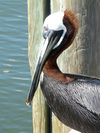
Custom Search
Animals in Aruba
Aruba is an island in the southern Caribbean just off the coast of Venezuela. The island has an area of approximately seventy square miles. The average temperature is 82 degrees and average rainfall is just over 16 inches. This results in an overall climate that is warm, but not tropical. These semi-arid conditions result in a landscape with many brush trees, and cacti.
With its warm, dry climate, most of Aruba's indigenous species are reptiles or birds. One of the most flamboyant birds is the Prikichi, or Caribbean parakeet. These beauties boast bright green plumage and yellow-orange heads. In addition to their striking colors, they are also quite vocal and are often heard before they are seen. The smallest birds in Aruba are the blenchi. These jewel toned hummingbirds birds hover in mid-air in front of flowering bushes and cacti to suck up their nectar. Aruba's birds of prey include the Warawara, an eagle-like bird, and the endangered Shoco, a small burrowing owl that is native to Aruba. This island also attracts
burrowing owl that is native to Aruba. This island also attracts  brown Pelicans and seven different types of Tern as well as Blue Heron,
brown Pelicans and seven different types of Tern as well as Blue Heron,  Green Heron, and both the Cattle and the
Green Heron, and both the Cattle and the  Snowy Egret.
Snowy Egret.
Aruba is the sole home of the Aruban cascabel rattlesnake which is now critically endangered. It is also the only place you will find the Aruba Leaf-toed Gecko and the Aruba Whiptail lizard. One half of all known lizard species live on Aruba. Other reptiles on the island include Baker's cat-eyed snake, an abundance of iguanas, and turtles including the leatherback, hawksbill, loggerhead, and green turtle.
Aruba is also home to animals brought over by different groups of settlers. These include the cottontail rabbit, most likely brought by settlers from Venezuela, and sheep, goats, and donkeys brought by the Spanish. Although the donkeys had once declined in number they are now often seen in groups of three of four in the more rugged areas of the island.
With its warm, dry climate, most of Aruba's indigenous species are reptiles or birds. One of the most flamboyant birds is the Prikichi, or Caribbean parakeet. These beauties boast bright green plumage and yellow-orange heads. In addition to their striking colors, they are also quite vocal and are often heard before they are seen. The smallest birds in Aruba are the blenchi. These jewel toned hummingbirds birds hover in mid-air in front of flowering bushes and cacti to suck up their nectar. Aruba's birds of prey include the Warawara, an eagle-like bird, and the endangered Shoco, a small




Aruba is the sole home of the Aruban cascabel rattlesnake which is now critically endangered. It is also the only place you will find the Aruba Leaf-toed Gecko and the Aruba Whiptail lizard. One half of all known lizard species live on Aruba. Other reptiles on the island include Baker's cat-eyed snake, an abundance of iguanas, and turtles including the leatherback, hawksbill, loggerhead, and green turtle.
Aruba is also home to animals brought over by different groups of settlers. These include the cottontail rabbit, most likely brought by settlers from Venezuela, and sheep, goats, and donkeys brought by the Spanish. Although the donkeys had once declined in number they are now often seen in groups of three of four in the more rugged areas of the island.
Dolphins, porpoises, and whales in Aruba
Grey dolphin Fraser's dolphinBats in Aruba
Southern long-nosed batDugongs, manatees, and sea cows in Aruba
American manatee Information about the animals living in Aruba is brought to you by "List of countries of the world", your first stop in discovering all countries and animals of the world.
Information about the animals living in Aruba is brought to you by "List of countries of the world", your first stop in discovering all countries and animals of the world.The animals displayed on this page are grouped in their scientific order. View also countries of the world ordered by:
- List of TLD's
- Country dialling codes
- Population
- Kilometers of coastline
- Square kilometers of land
- Square kilometers of water
- Birth rate
- Death rate
- Irrigated land
- Countries starting with A
Privacy policy